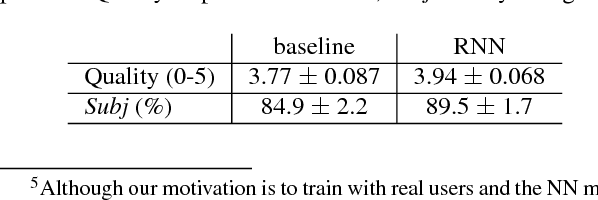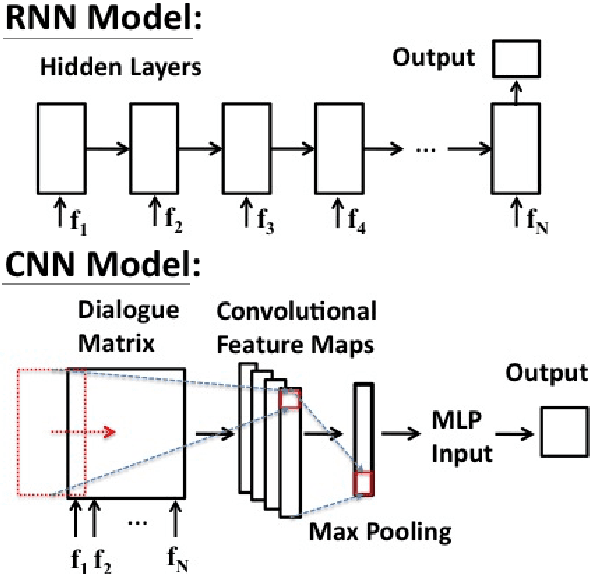Nikola Mrksic
A Network-based End-to-End Trainable Task-oriented Dialogue System
Apr 24, 2017Abstract:Teaching machines to accomplish tasks by conversing naturally with humans is challenging. Currently, developing task-oriented dialogue systems requires creating multiple components and typically this involves either a large amount of handcrafting, or acquiring costly labelled datasets to solve a statistical learning problem for each component. In this work we introduce a neural network-based text-in, text-out end-to-end trainable goal-oriented dialogue system along with a new way of collecting dialogue data based on a novel pipe-lined Wizard-of-Oz framework. This approach allows us to develop dialogue systems easily and without making too many assumptions about the task at hand. The results show that the model can converse with human subjects naturally whilst helping them to accomplish tasks in a restaurant search domain.
Dialogue manager domain adaptation using Gaussian process reinforcement learning
Sep 09, 2016



Abstract:Spoken dialogue systems allow humans to interact with machines using natural speech. As such, they have many benefits. By using speech as the primary communication medium, a computer interface can facilitate swift, human-like acquisition of information. In recent years, speech interfaces have become ever more popular, as is evident from the rise of personal assistants such as Siri, Google Now, Cortana and Amazon Alexa. Recently, data-driven machine learning methods have been applied to dialogue modelling and the results achieved for limited-domain applications are comparable to or outperform traditional approaches. Methods based on Gaussian processes are particularly effective as they enable good models to be estimated from limited training data. Furthermore, they provide an explicit estimate of the uncertainty which is particularly useful for reinforcement learning. This article explores the additional steps that are necessary to extend these methods to model multiple dialogue domains. We show that Gaussian process reinforcement learning is an elegant framework that naturally supports a range of methods, including prior knowledge, Bayesian committee machines and multi-agent learning, for facilitating extensible and adaptable dialogue systems.
Conditional Generation and Snapshot Learning in Neural Dialogue Systems
Jun 10, 2016



Abstract:Recently a variety of LSTM-based conditional language models (LM) have been applied across a range of language generation tasks. In this work we study various model architectures and different ways to represent and aggregate the source information in an end-to-end neural dialogue system framework. A method called snapshot learning is also proposed to facilitate learning from supervised sequential signals by applying a companion cross-entropy objective function to the conditioning vector. The experimental and analytical results demonstrate firstly that competition occurs between the conditioning vector and the LM, and the differing architectures provide different trade-offs between the two. Secondly, the discriminative power and transparency of the conditioning vector is key to providing both model interpretability and better performance. Thirdly, snapshot learning leads to consistent performance improvements independent of which architecture is used.
Continuously Learning Neural Dialogue Management
Jun 08, 2016



Abstract:We describe a two-step approach for dialogue management in task-oriented spoken dialogue systems. A unified neural network framework is proposed to enable the system to first learn by supervision from a set of dialogue data and then continuously improve its behaviour via reinforcement learning, all using gradient-based algorithms on one single model. The experiments demonstrate the supervised model's effectiveness in the corpus-based evaluation, with user simulation, and with paid human subjects. The use of reinforcement learning further improves the model's performance in both interactive settings, especially under higher-noise conditions.
On-line Active Reward Learning for Policy Optimisation in Spoken Dialogue Systems
Jun 02, 2016



Abstract:The ability to compute an accurate reward function is essential for optimising a dialogue policy via reinforcement learning. In real-world applications, using explicit user feedback as the reward signal is often unreliable and costly to collect. This problem can be mitigated if the user's intent is known in advance or data is available to pre-train a task success predictor off-line. In practice neither of these apply for most real world applications. Here we propose an on-line learning framework whereby the dialogue policy is jointly trained alongside the reward model via active learning with a Gaussian process model. This Gaussian process operates on a continuous space dialogue representation generated in an unsupervised fashion using a recurrent neural network encoder-decoder. The experimental results demonstrate that the proposed framework is able to significantly reduce data annotation costs and mitigate noisy user feedback in dialogue policy learning.
Multi-domain Neural Network Language Generation for Spoken Dialogue Systems
Mar 03, 2016



Abstract:Moving from limited-domain natural language generation (NLG) to open domain is difficult because the number of semantic input combinations grows exponentially with the number of domains. Therefore, it is important to leverage existing resources and exploit similarities between domains to facilitate domain adaptation. In this paper, we propose a procedure to train multi-domain, Recurrent Neural Network-based (RNN) language generators via multiple adaptation steps. In this procedure, a model is first trained on counterfeited data synthesised from an out-of-domain dataset, and then fine tuned on a small set of in-domain utterances with a discriminative objective function. Corpus-based evaluation results show that the proposed procedure can achieve competitive performance in terms of BLEU score and slot error rate while significantly reducing the data needed to train generators in new, unseen domains. In subjective testing, human judges confirm that the procedure greatly improves generator performance when only a small amount of data is available in the domain.
Semantically Conditioned LSTM-based Natural Language Generation for Spoken Dialogue Systems
Aug 26, 2015



Abstract:Natural language generation (NLG) is a critical component of spoken dialogue and it has a significant impact both on usability and perceived quality. Most NLG systems in common use employ rules and heuristics and tend to generate rigid and stylised responses without the natural variation of human language. They are also not easily scaled to systems covering multiple domains and languages. This paper presents a statistical language generator based on a semantically controlled Long Short-term Memory (LSTM) structure. The LSTM generator can learn from unaligned data by jointly optimising sentence planning and surface realisation using a simple cross entropy training criterion, and language variation can be easily achieved by sampling from output candidates. With fewer heuristics, an objective evaluation in two differing test domains showed the proposed method improved performance compared to previous methods. Human judges scored the LSTM system higher on informativeness and naturalness and overall preferred it to the other systems.
Reward Shaping with Recurrent Neural Networks for Speeding up On-Line Policy Learning in Spoken Dialogue Systems
Aug 18, 2015



Abstract:Statistical spoken dialogue systems have the attractive property of being able to be optimised from data via interactions with real users. However in the reinforcement learning paradigm the dialogue manager (agent) often requires significant time to explore the state-action space to learn to behave in a desirable manner. This is a critical issue when the system is trained on-line with real users where learning costs are expensive. Reward shaping is one promising technique for addressing these concerns. Here we examine three recurrent neural network (RNN) approaches for providing reward shaping information in addition to the primary (task-orientated) environmental feedback. These RNNs are trained on returns from dialogues generated by a simulated user and attempt to diffuse the overall evaluation of the dialogue back down to the turn level to guide the agent towards good behaviour faster. In both simulated and real user scenarios these RNNs are shown to increase policy learning speed. Importantly, they do not require prior knowledge of the user's goal.
Learning from Real Users: Rating Dialogue Success with Neural Networks for Reinforcement Learning in Spoken Dialogue Systems
Aug 13, 2015



Abstract:To train a statistical spoken dialogue system (SDS) it is essential that an accurate method for measuring task success is available. To date training has relied on presenting a task to either simulated or paid users and inferring the dialogue's success by observing whether this presented task was achieved or not. Our aim however is to be able to learn from real users acting under their own volition, in which case it is non-trivial to rate the success as any prior knowledge of the task is simply unavailable. User feedback may be utilised but has been found to be inconsistent. Hence, here we present two neural network models that evaluate a sequence of turn-level features to rate the success of a dialogue. Importantly these models make no use of any prior knowledge of the user's task. The models are trained on dialogues generated by a simulated user and the best model is then used to train a policy on-line which is shown to perform at least as well as a baseline system using prior knowledge of the user's task. We note that the models should also be of interest for evaluating SDS and for monitoring a dialogue in rule-based SDS.
Stochastic Language Generation in Dialogue using Recurrent Neural Networks with Convolutional Sentence Reranking
Aug 07, 2015



Abstract:The natural language generation (NLG) component of a spoken dialogue system (SDS) usually needs a substantial amount of handcrafting or a well-labeled dataset to be trained on. These limitations add significantly to development costs and make cross-domain, multi-lingual dialogue systems intractable. Moreover, human languages are context-aware. The most natural response should be directly learned from data rather than depending on predefined syntaxes or rules. This paper presents a statistical language generator based on a joint recurrent and convolutional neural network structure which can be trained on dialogue act-utterance pairs without any semantic alignments or predefined grammar trees. Objective metrics suggest that this new model outperforms previous methods under the same experimental conditions. Results of an evaluation by human judges indicate that it produces not only high quality but linguistically varied utterances which are preferred compared to n-gram and rule-based systems.
 Add to Chrome
Add to Chrome Add to Firefox
Add to Firefox Add to Edge
Add to Edge